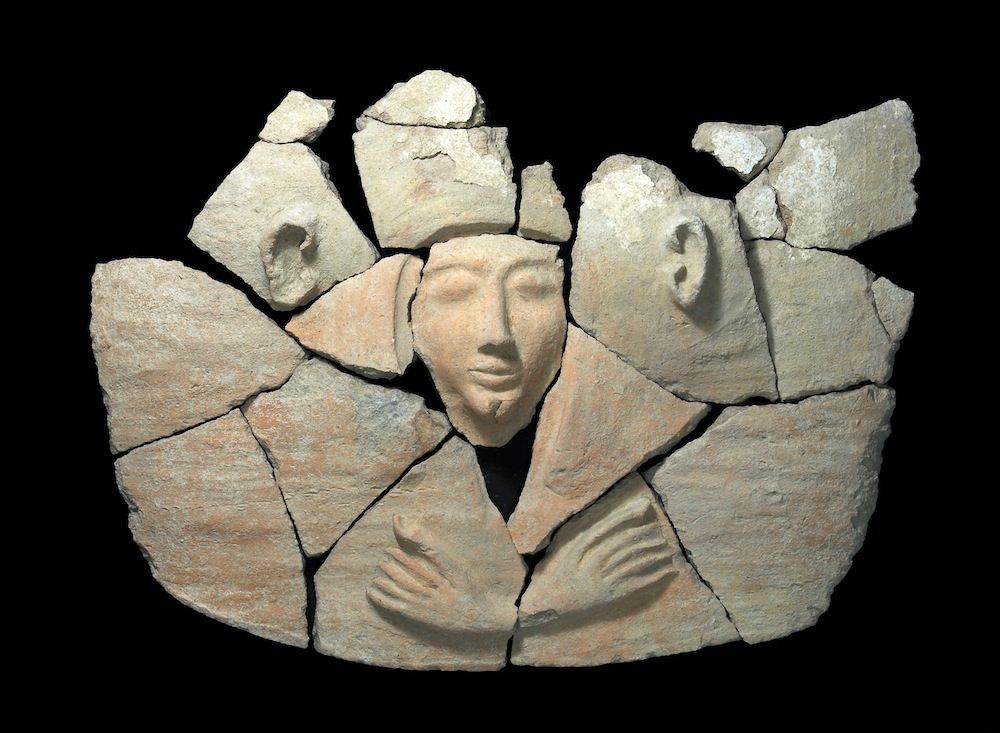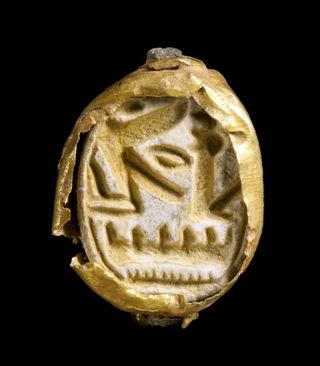Sculpted Face Peers Out from Ancient Coffin Found in Israel

A newly discovered coffin that dates back 3,300 years likely belonged to a wealthy elite, perhaps an Egyptian army officer, archaeologists have announced.
The grave site, uncovered in Israel, was filled with food storage vessels, animal bones and tableware, the Israel Antiquities Authority (IAA) reported today (April 9). A clay coffin with a lid sculpted to look like a person contained an adult skeleton surrounded by hammered pieces of bronze, as well as a bronze dagger and bowl. The skeleton was also buried with a gold ring bearing the name of Seti I, an Egyptian pharaoh who ruled from around 1290 B.C. to 1279 B.C.
"Since the vessels interred with the individual were produced locally, we assume the deceased was an official of Canaanite origin who was engaged in the service of the Egyptian government," the IAA archaeologists reported. Canaan is an ancient region that roughly encompassed modern-day Lebanon, Israel and Palestine. [See Images of the Coffin and Artifacts]
Grave discovery
The IAA conducted excavations in advance of the construction of a natural gas pipeline by the Israel Natural Gas Lines Company. The archaeologists, led by Edwin van den Brink, Dan Kirzner and Ron Be'eri, discovered the Late Bronze Age coffin and grave offerings, as well as four nearby graves containing two men and two women who may have been relatives of the person in the clay coffin.
The man-shaped coffin was in the Egyptian style. At the time of the burial, Egyptian rule extended into Canaan, and the wealthy elite followed Egyptian traditions.
"An ordinary person could not afford the purchase of such a coffin," van den Brink and his colleagues said. "It is obvious the deceased was a member of the local elite."
Sign up for the Live Science daily newsletter now
Get the world’s most fascinating discoveries delivered straight to your inbox.

Next to the skeleton, archaeologists found a gold Egyptian scarab seal attached to a ring. The seal, which would have been used to stamp documents, bore the symbol of a cobra and the name of Seti I, who established Egyptian power in Canaan.
Ancient politics
It's possible that the individual in the grave was not an elite Canaanite, but an Egyptian official who died abroad, the researchers added. The IAA is considering sampling DNA from the skeleton to attempt to determine the person's origin.
The grave site is in the Jezreel Valley, a region in Israel rich in artifacts and history. Another cemetery dating to Seti I's reign has been found in the northern end of the valley. Thousands of years before, during the Stone Age, two young people fell (or were pushed) into a water well on the western side of the valley. Archaeologists have also discovered a headless Hercules statue in the region that probably decorated a Roman bathhouse in the 2nd century A.D.
Follow Stephanie Pappas on Twitter and Google+. Follow us @livescience, Facebook & Google+. Original article on Live Science.

Stephanie Pappas is a contributing writer for Live Science, covering topics ranging from geoscience to archaeology to the human brain and behavior. She was previously a senior writer for Live Science but is now a freelancer based in Denver, Colorado, and regularly contributes to Scientific American and The Monitor, the monthly magazine of the American Psychological Association. Stephanie received a bachelor's degree in psychology from the University of South Carolina and a graduate certificate in science communication from the University of California, Santa Cruz.










